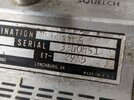I have this really cool GE combination radio. I think the part number is HN31N6 and appears to have been modified to work on bands 76 & 94. The only documentation I'm found for this portable radio is this (it has nothing to do with the radio itself) https://lfsrv2.cityofsavage.com/WebLinkExternal/DocView.aspx?dbid=0&id=9002&page=1&cr=1
Any chance anyone has any information they could provide? A link to a description of the radio or who used it and how etc. would be appreciated.
Any chance anyone has any information they could provide? A link to a description of the radio or who used it and how etc. would be appreciated.
Attachments
-
 PXL_20240503_184905232.MP.jpg5.1 MB · Views: 29
PXL_20240503_184905232.MP.jpg5.1 MB · Views: 29 -
 PXL_20240503_184925481.MP.jpg4.6 MB · Views: 29
PXL_20240503_184925481.MP.jpg4.6 MB · Views: 29 -
 PXL_20240503_185007350.MP.jpg4.5 MB · Views: 29
PXL_20240503_185007350.MP.jpg4.5 MB · Views: 29 -
 PXL_20240503_185022783.MP.jpg3.8 MB · Views: 27
PXL_20240503_185022783.MP.jpg3.8 MB · Views: 27 -
 PXL_20240503_185025261.MP.jpg3.4 MB · Views: 30
PXL_20240503_185025261.MP.jpg3.4 MB · Views: 30 -
 PXL_20240503_185125259.MP.jpg3.7 MB · Views: 29
PXL_20240503_185125259.MP.jpg3.7 MB · Views: 29 -
 PXL_20240503_185323680.MP.jpg4.4 MB · Views: 27
PXL_20240503_185323680.MP.jpg4.4 MB · Views: 27
